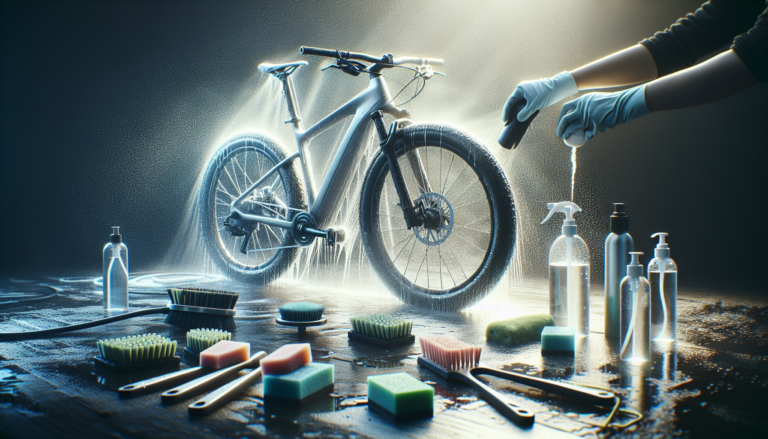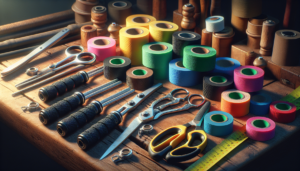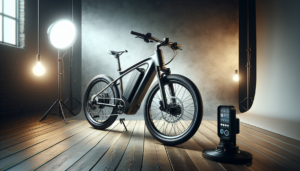Why Regular Bike Cleaning is Essential
Keeping your bicycle clean is a crucial aspect of bike maintenance that should not be overlooked. Regular cleaning not only keeps your bike looking good but also ensures its longevity and optimal performance. Mud, grime, and debris can accumulate on various components, leading to wear and tear, reduced efficiency, and even potential safety hazards.
Benefits of Regular Bike Cleaning
By incorporating a consistent bike cleaning routine, you can enjoy several benefits:
- Improved performance: A clean bike operates more smoothly, with well-lubricated components and minimal friction.
- Extended lifespan: Regular cleaning prevents the buildup of dirt and grime that can cause premature wear on components.
- Enhanced safety: Clean brakes, chains, and derailleurs ensure reliable and responsive operation, reducing the risk of accidents.
- Early issue detection: While cleaning, you have the opportunity to closely inspect your bike and identify any potential issues before they escalate.
Signs Your Bike Needs Cleaning
It’s important to recognize when your bike requires cleaning. Some telltale signs include:
- A black, greasy chain: If your chain appears excessively dirty or greasy, it’s time for a thorough cleaning.
- Visible dirt and grime: Mud, dust, and road grime accumulating on the frame and components indicate the need for a wash.
- Unusual noises: Excessive chain noise or squeaking can be a sign that your bike needs cleaning and lubrication.
- Reduced performance: If you notice a decrease in shifting smoothness or braking responsiveness, it may be due to a dirty drivetrain.
Essential Bike Cleaning Supplies
To effectively clean your bike, you’ll need the right supplies. Here are the essential items to have on hand:
Must-Have Cleaning Tools
- Clean rags or microfiber towels
- Brushes of various sizes and stiffness
- Bucket or container for water
- Sponges or soft scrubbers
- Hose or water source
These tools will help you tackle different parts of your bike, from the frame to the drivetrain components. Brushes are particularly useful for dislodging dirt and grime from hard-to-reach areas.
Choosing the Right Cleaning Products
In addition to tools, you’ll need the appropriate cleaning products. Some key products to consider include:
- Bike wash cleaner: A specialized cleaning solution designed for bike frames and components.
- Degreaser: Used for cleaning the chain, cassette, and chainrings.
- Chain lubricant: Applied after cleaning to keep the chain running smoothly.
- Dish soap: A mild, readily available alternative for general bike washing.
When selecting cleaning products, opt for formulas that are safe for bike components and environmentally friendly. Avoid harsh chemicals that can damage finishes or degrade rubber seals.
Step-by-Step Bike Cleaning Process
Now that you have your supplies ready, let’s walk through the step-by-step process of cleaning your bike:
Preparing Your Bike for Cleaning
Before you begin, it’s essential to prepare your bike and workspace:
- Set up your bike on a stand or lean it against a stable surface.
- Remove any accessories, such as water bottles or bags.
- Fill a bucket with warm soapy water using mild dish soap.
- Gather your cleaning supplies within reach.
A bike stand can be incredibly helpful, as it allows you to rotate the bike and access all areas easily. If you don’t have a stand, you can still clean your bike effectively by leaning it securely against a wall or fence.
Cleaning the Bike Frame
Start by cleaning the bike frame:
- Using a soft sponge or cloth, apply the soapy water to the frame.
- Scrub gently to remove dirt and grime, paying attention to crevices and tight spaces.
- Use a soft-bristled brush to clean hard-to-reach areas.
- Rinse the frame thoroughly with clean water.
- Dry the frame with a clean towel to prevent water spots.
Be cautious around bearing systems, such as the headset, bottom bracket, and hubs. Avoid spraying water directly at these areas to prevent contamination.
Cleaning and Lubricating the Chain
A clean and well-lubricated chain is crucial for smooth shifting and optimal drivetrain performance. Here’s how to clean and lubricate your chain:
- Apply a degreaser to the chain and let it sit for a few minutes.
- Use a chain cleaning tool or brush to scrub the chain thoroughly, removing built-up grime.
- Rinse the chain with water and dry it with a clean rag.
- Apply a high-quality chain lubricant, distributing it evenly across the links.
- Wipe off any excess lubricant to prevent attracting dirt.
The type of lubricant you use depends on your riding conditions. Wet lubricants are best for wet and muddy environments, while dry lubricants are ideal for dry, dusty conditions.
Cleaning the Drivetrain
The drivetrain includes the cassette, chainrings, and derailleurs. To clean these components:
- Apply degreaser to the cassette, chainrings, and derailleurs.
- Use a stiff-bristled brush to scrub away dirt and buildup.
- Rinse the components with water and dry them thoroughly.
- Apply a light coating of lubricant to the derailleur pivots and pulleys.
Pay special attention to the jockey wheels on the rear derailleur, as they can accumulate significant amounts of grime.
Cleaning the Wheels and Tires
Don’t forget to give your wheels and tires some attention:
- Remove the wheels from the bike for easier access.
- Clean the rims, spokes, and hubs with soapy water and a soft brush.
- Scrub the tires to remove any embedded debris.
- Rinse the wheels thoroughly and dry them with a clean towel.
- Inspect the tires for any cuts, tears, or excessive wear.
If you have disc brakes, be careful not to contaminate the brake rotors with cleaning products or lubricants.
Final Steps: Reassembly and Lubrication
After cleaning all the components, it’s time for reassembly and final lubrication:
- Reinstall the wheels, making sure they are securely fastened.
- Lubricate the chain as described earlier.
- Apply a light coating of lubricant to the brake and derailleur levers, as well as any exposed cable ends.
- Check that all bolts and quick-release levers are properly tightened.
Give your bike a final wipe-down with a clean, dry cloth to remove any remaining moisture or lubricant residue.
Special Considerations for Different Types of Bikes
While the general cleaning process remains similar, there are some specific considerations for different types of bikes:
Cleaning a Mountain Bike
Mountain bikes are subjected to more extreme conditions and require more frequent cleaning:
- Pay extra attention to the suspension components, ensuring they are clean and well-lubricated.
- Use a stiff brush to remove caked-on mud and debris from the frame and wheels.
- Clean and lubricate the dropper seatpost if your bike has one.
After particularly muddy rides, it’s a good idea to give your mountain bike a thorough cleaning to prevent dirt from damaging the components.
Cleaning a Road Bike
Road bikes generally stay cleaner than mountain bikes but still require regular maintenance:
- Focus on keeping the drivetrain clean and well-lubricated to ensure smooth shifting.
- Pay attention to the brake pads and rims, ensuring they are free from grit and debris.
- Use a soft brush or cloth to clean the frame, avoiding excessive water near the bottom bracket and headset.
Regular cleaning and lubrication will help keep your road bike running efficiently and extend the life of its components.
Common Mistakes to Avoid
When cleaning your bike, there are a few common mistakes to watch out for:
Using High-Pressure Water
While it may be tempting to blast your bike with a high-pressure hose, this can actually cause damage:
- High-pressure water can force dirt and grime into bearings and seals, leading to premature wear.
- It can also wash away important lubrication from pivot points and bearing systems.
Instead of using a high-pressure hose, stick to low-pressure water from a garden hose or bucket.
Neglecting Lubrication
After cleaning your bike, it’s crucial to re-lubricate the necessary components:
- Failing to lubricate the chain, derailleurs, and other moving parts can lead to increased friction and wear.
- Use a quality lubricant and apply it sparingly, wiping off any excess to prevent attracting dirt.
A well-lubricated bike will run smoothly, shift better, and last longer.
Maintaining Your Bike Between Cleanings
While regular cleaning is important, there are also steps you can take to maintain your bike between full cleanings:
Quick Cleaning Tips
- Wipe down the frame and components with a damp cloth after every ride.
- Use a dry rag to remove excess moisture and prevent corrosion.
- Quickly clean and lubricate the chain if it appears dry or dirty.
- Check tire pressure and inspect for any debris or damage.
These quick maintenance tasks can go a long way in keeping your bike running smoothly between more thorough cleanings.
Storing Your Bike Properly
Proper bike storage can also help reduce the need for frequent cleanings:
- Store your bike in a dry, indoor location to protect it from the elements.
- Use a bike cover if storing outdoors to prevent dust and debris accumulation.
- Avoid storing your bike in damp areas, as this can promote rust and corrosion.
By storing your bike properly, you can minimize exposure to dirt, grime, and moisture, reducing the frequency of required cleanings.
When to Seek Professional Help
While most bike cleaning and maintenance tasks can be done at home, there are times when professional help may be necessary:
Signs You Need Professional Cleaning
- If you notice unusual noises or poor performance even after cleaning and lubricating.
- If you are unsure about how to properly clean or maintain certain components.
- If your bike has been exposed to extreme conditions or has gone a long time without maintenance.
Professional bike mechanics have the knowledge, tools, and expertise to thoroughly clean and service your bike, ensuring optimal performance and longevity.
Finding a Reliable Bike Shop
When seeking professional help, it’s important to find a reputable bike shop:
- Look for a shop with certified mechanics and a good reputation in the cycling community.
- Ask for recommendations from fellow cyclists or check online reviews.
- Consider the shop’s experience with your specific type of bike.
A reliable bike shop will not only clean your bike thoroughly but also inspect it for any potential issues and provide expert advice on maintenance and care.






